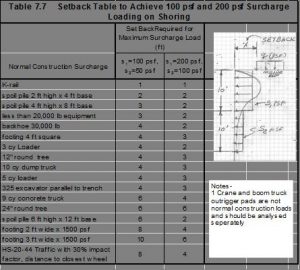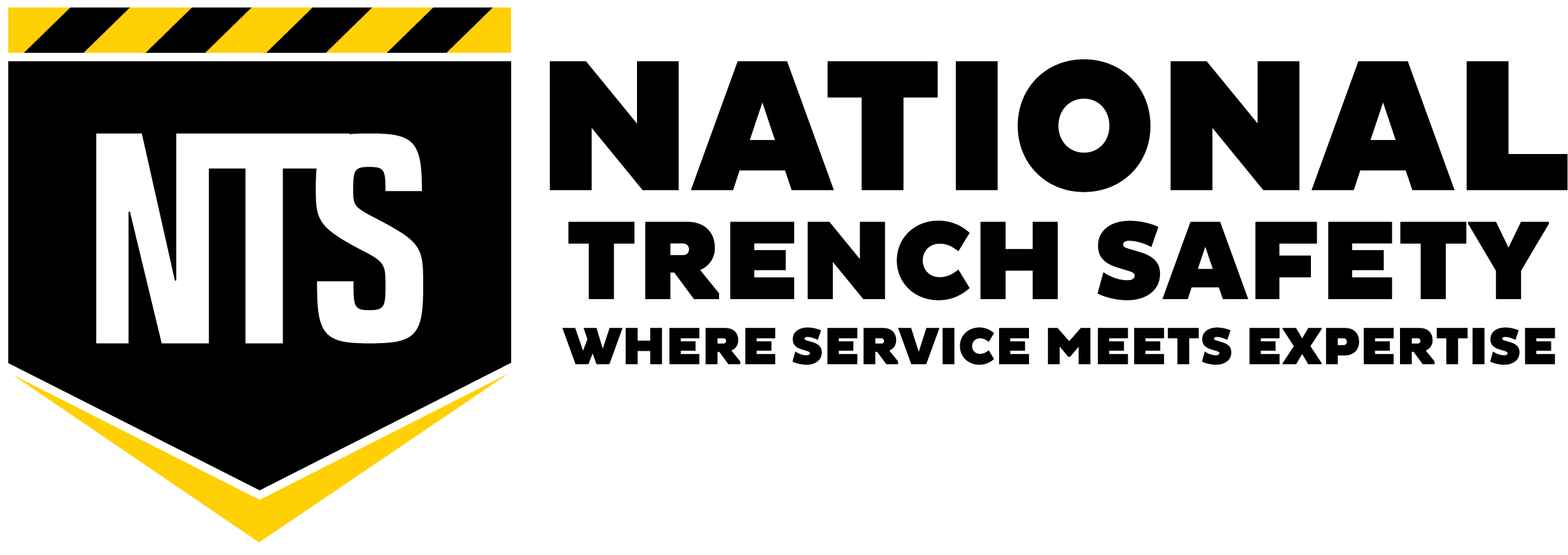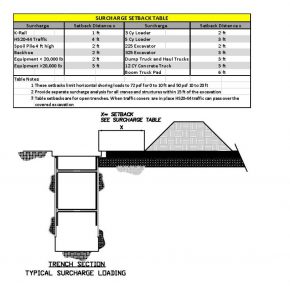Knowledge Article: Surcharge Load Decisions for the Competent Person
One of the most complicated and least understood requirements of the OSHA Subpart P-Excavations Standard is surcharge loading. There is very little information provided about how to determine and deal with surcharge loads, while there is a lot about requiring the competent person to consider surcharge loads in shoring selection decisions. Here is the requirement from the Excavations Standard:
1926.652(a)(2)Protective systems shall have the capacity to resist without failure all loads that are intended or could reasonably be expected to be applied or transmitted to the system.
Protective system loads come from 3 distinct sources:
1. The soil
2. Water
3. Surcharge loads
A surcharge load is the result of objects on the surface that add loading to the protective system. This applies equally to relief protective systems, (open cut), or support systems (shored).
The figure to the right below shows a typical surcharge load table developed by National Trench Safety’s Engineering Department for their use in a site specific plan.
When the employer and its competent person decide on the worker protective system they are going to use, they must consider the effect of all 3 sources above. The effect of water is removed by always maintaining the water at or below the bottom of the excavation.
As a rule tabulated data is developed with the assumption that surcharge loads are less than 20,000 lbs or 2 ft of additional soil loading , for instance, in Appendix B-Sloping and Benching the following statement is found:
(iii) When surcharge loads from stored material or equipment, operating equipment, or traffic are present, a competent person shall determine the degree to which the actual slope must be reduced below the maximum allowable slope, and shall assure that such reduction is achieved. Surcharge loads from adjacent structures shall be evaluated in accordance with § 1926.651(i)Also, in Appendix C-Timber Shoring exceptions to the tabulated data are found in the following statements:
(A) When loads imposed by structures or by stored material adjacent to the trench weigh in excess of the load imposed by a two-foot soil surcharge. The term “adjacent” as used here means the area within a horizontal distance from the edge of the trench equal to the depth of the trench.
(C) When surcharge loads are present from equipment weighing in excess of 20,000 pounds.
Also, in Appendix D-Aluminum hydraulic shoring, statement (C) from above is again used.
Surcharge loads are an additional destabilizing factor on sloped excavations and they increase the loading on trench wall support systems such as shields and hydraulic shores.
Some other important facts about these loads that should be understood by the competent person are:
- The closer the load is to the edge of the trench the greater the loading on the shoring system
- At close setbacks the loading is greater near the surface, for example that might be the first 5 ft from the top of the excavation with at a 2 ft setback depending on soil conditions. As the depth of the excavation continues, the load is dramatically reduced beyond that depth.
- As the surcharge load is set back from the edge of the trench the overall loading is decreased and the point at which maximum loading peaks along the vertical plane of the trench wall is deeper.
- Tabulated data providing allowable depth for shoring equipment is generally developed by subtracting 75 PSF for surcharge loads from the calculated strength of the equipment before calculating the allowable depth, although tabulated data and or a registered professional engineer may need to be consulted.
In the case of surcharge loading, the task at hand for the competent person is to make sure that the loads do not destabilize slopes or exceed the allowable loading of the shoring equipment. There are two ways to control surcharge loads:
- Reduce or spread the load
- Set the load further away from the edge of the trench
There are other surcharge load mitigating factors that help reduce the consequences of surcharge loading on shoring systems.
- After approximately the first ten feet the surcharge load decreases with depth while the soil loading usually increases with depth. The point is that where surcharge loading is high the soil loading is low and where surcharge loading is low the soil loading is high.
- Wheel loads from construction equipment and traffic are intense at the location of the wheel but become insignificant after approximately 10 ft in either direction forward or backward along the trench, therefore the overall effect is averaged out over the length of the shoring. It is reasonable to average wheel loading in the horizontal and vertical directions.
- Shoring equipment is not normally used at maximum allowable depth or PSF rating. The residual strength not used to support the soil can be used to support surcharge effects. A shoring shield with an 1100 PSF capacity used at a depth requiring 900 PSF capacity has an additional 200 PSF to support surcharge loads. The competent person can factor this in when deciding about setback.
With engineered worker protection systems it has become common practice to provide an equipment setback table so that calculated loads are not exceeded and the competent person does not have to guess at the setbacks. With engineered shoring systems the surcharge loads are always analyzed and considered in the design.
Table 7.7 below gives setback distances required to maintain a 100 PSF and a 200 PSF surcharge effect on shoring equipment. As an example from the table a spoil pile that is 6 ft high and has a 12 ft base set back 2 ft from the edge of a trench will produce a 200 PSF lateral force on the shoring for the first 10 ft of depth and 100 PSF from 10 ft to 20 ft deep. After 20 ft depth at this setback there would be very little effect from the spoil pile. If the pile is set back 6 ft the respective loading would be reduced to 100 PSF and 50 PSF. The peak of the load would be a little deeper.
that is 6 ft high and has a 12 ft base set back 2 ft from the edge of a trench will produce a 200 PSF lateral force on the shoring for the first 10 ft of depth and 100 PSF from 10 ft to 20 ft deep. After 20 ft depth at this setback there would be very little effect from the spoil pile. If the pile is set back 6 ft the respective loading would be reduced to 100 PSF and 50 PSF. The peak of the load would be a little deeper.
The competent person should always read manufacturer’s tabulated data for the shoring equipment being used as applies to surcharge loads and set back heavy loads appropriately. NTS’ Engineering Department is always available to answer any questions that arise regarding surcharge loading.
About the Author:
Joe Turner, P.E. serves as National Trench Safety’s Director of Engineering, Research and Product Development. Mr. Turner is one of the most recognized figures in the trench safety industry, having provided trench safety plans for the last 20 years. Among his many accomplishments, is the book Excavation Systems, Design, Planning and Safety, which was published by McGraw-Hill in 2008 and is still used today as a reference for many students and professionals regarding proper engineering techniques.
DISCLAIMER: the information contained in this article is provided for general and illustrative purposes only and is not to be considered Site Specific and or designated engineering for any project or work zone, nor is it to be used or consider to be tabulated data, technical data, advice and or counsel to be used on any jobsite. Each project is different and is the responsibility of the employer’s designated Competent Person to make decisions upon what systems and methods may be used in compliance with the federal and local regulations, manufactures tabulated data, engineered drawings and other plans.






